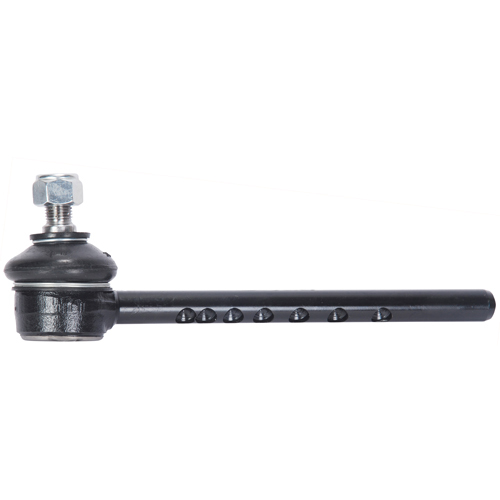Product Description
Tie rod ends are essential components of a vehicle's steering system. They connect the steering rack or gearbox to the steering knuckle, allowing for the controlled movement and alignment of the front wheels. Tie rod ends play a crucial role in ensuring precise steering and maintaining stability while driving.
FAQs:
Q: What is the purpose of tie rod ends?
A: Tie rod ends serve as a link between the steering system and the front wheels of a vehicle. They transmit the motion from the steering rack or gearbox to the steering knuckle, which enables the wheels to turn and change direction. Tie rod ends are responsible for translating the steering input from the driver into the necessary movement of the wheels.
Q: How do tie rod ends work?
A: Tie rod ends consist of a threaded rod with a ball joint at one end. The ball joint is connected to the steering knuckle, while the threaded end is attached to the steering rack or gearbox. As the driver turns the steering wheel, the rotational motion is transferred to the tie rod ends, which articulate and cause the front wheels to turn accordingly.
Q: What are the signs of worn or failing tie rod ends?
A: Some common signs of worn or failing tie rod ends include uneven tire wear, excessive play or looseness in the steering, vibrations or shaking while driving, and a noticeable pull to one side when steering. Clunking or knocking sounds from the front suspension may also indicate a problem with the tie rod ends.
Q: Can I drive with worn tie rod ends?
A: It is not recommended to drive with worn tie rod ends. These components play a critical role in maintaining steering control and stability. If the tie rod ends are severely worn or damaged, it can lead to unpredictable steering behavior, loss of control, and potentially dangerous situations. It is best to have them inspected and replaced if necessary.
Q: How often should tie rod ends be inspected or replaced?
A: Tie rod ends should be inspected regularly as part of routine vehicle maintenance, especially during wheel alignments or suspension checks. However, the lifespan of tie rod ends can vary depending on driving conditions and other factors. If any signs of wear or damage are noticed, they should be promptly addressed, and if needed, replaced by a qualified mechanic.
Q: Can tie rod ends be replaced individually, or should they be replaced in pairs?
A: It is generally recommended to replace tie rod ends in pairs. This helps to ensure uniformity and balanced performance in the steering system. If one tie rod end is worn or damaged, the other is likely to have experienced similar stress and may be nearing its lifespan as well. Replacing both tie rod ends simultaneously helps maintain the integrity and reliability of the steering system.
Precision and Durability You Can Rely OnOur tie rod ends are machined to tight tolerances for optimal steering accuracy and wear resistance. The use of corrosion-resistant coatings and induction-hardened alloy steel ensures prolonged service life, even under demanding conditions. The rubber boot fitted over the ball pin provides exceptional protection against contamination for maintenance-free performance.
Engineered for Easy InstallationDesigned for direct OE replacement, our tie rod ends allow for quick, hassle-free installation. Available in individually packaged or boxed formats, each tie rod end is stamped with its part number for straightforward identification and compatibility with a wide range of vehicle makes and models, including Toyota, Honda, and Ford.
Versatile Solutions for Multiple Vehicle TypesWhether youre servicing a car, pickup van, truck, or commercial vehicle, our tie rod ends can be supplied with male or female end connections as required. Their robust construction supports heavy mechanical loads and ensures compatibility and reliability across various vehicle platforms.
FAQs of TIE ROD ENDS:
Q: How do I identify the correct tie rod end for my vehicle?
A: Each tie rod end is stamped with its part number and is manufactured to match OE specifications for different car makes. Check your vehicles OE number and model information to select the appropriate part.
Q: What benefits do induction hardened alloy steel ball pins provide?
A: Induction-hardened alloy steel ball pins offer enhanced strength and wear resistance, leading to longer component life and reliable performance under challenging mechanical loads.
Q: When should tie rod ends be inspected and replaced?
A: It is recommended to inspect tie rod ends at regular service intervals or every 50,000 to 100,000 km during normal vehicle operation. Replacement should occur if there are signs of excessive wear, play, or steering issues.
Q: Where can these tie rod ends be used?
A: These tie rod ends are suitable for various automobile models, including trucks and commercial vehicles. Their robust design adapts to different vehicle applications, ensuring precise steering control.
Q: What installation process is required for these tie rod ends?
A: They are direct OE replacements designed for easy installation. Simply remove the old tie rod end and fit the new one as per your vehicles service manual, ensuring proper torque and connection.
Q: How does the rubber boot contribute to the tie rod ends performance?
A: The durable rubber boot effectively seals the ball pin, preventing entry of dirt and moisture. This maintains lubrication and prolongs both the tie rod ends life span and steering accuracy.
Q: What makes these tie rod ends resistant to corrosion?
A: They undergo rigorous salt spray testing (minimum 300 hours) and feature corrosion-resistant coatings, such as zinc plating or phosphating, protecting them from environmental damage.

